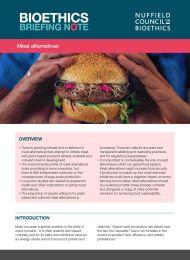Meat alternatives
Policy Briefing
Published 08/01/2020

Meat occupies a special position in the diets of many humans. It is often desired and valued culturally and for its taste and nutritional value as an energy-dense and rich source of protein and vitamins. Global meat production has tripled over the last four decades, due to an increase in the world’s population size, affluence, and dietary preferences.
Farming practices vary globally and carry social, cultural, and economic significance. Livestock farming employs millions of people, can deliver some environmental benefits by helping manage habitats for wildlife, allowing carbon storage, and providing landscapes for recreation. However, most animals farmed for meat worldwide are farmed intensively. This can result in significant use of freshwater, greenhouse gas emissions, soil degradation, pollution, and loss of biodiversity. There are longstanding concerns about the welfare of animals in certain farming systems, and some people have fundamental objections to the rearing and killing of animals for food.8 Meat production can contribute to public health risks such as the transmission of disease and antibiotic resistance,9 and high consumption of processed meat is associated with adverse health conditions.10 These problems support an ethical imperative to reduce meat production and consumption. International bodies, experts, and NGOs are calling for people to reduce the amount of meat in their diets, or to stop eating meat altogether.11
There is growing interest in meat alternatives that attempt to closely imitate meat produced from animals. Manufacturers of these kinds of products aim to fulfil people’s desire for meat, without the potentially harmful consequences of meat production.12 This briefing note takes a global view with particular reference to the UK context to consider the possible implications of meat alternatives for animal welfare, the environment, and human health, and their place within broader efforts to promote public health and sustainable food systems.
Box 1. Types of meat alternatives
There are two main types of meat alternatives that imitate meat produced from livestock:
- Plant-based meat alternatives use a biomimicry approach to create the taste and texture of meat without the use of any animal products, offering people a ‘viscerally equivalent’ experience to eating meat.
- Cultured meat alternatives are grown from the cells of an animal and seek ‘biological equivalence’ with livestock meat products without the slaughter of animals. These products are also known as cultivated or cell-based meats.
Definitions of what cultured meat ‘is’ and its status as a meat are still contested and at the heart of debates about how these foodstuffs should be regarded. Whilst cultured meat may be seen by some as meat, these categories are in many ways constructed, historically situated, and political, and may change over time based on the criteria used to define meat.
Box 2. Other responses to the impacts of livestock farming
There are a range of other approaches to mitigating the impacts of livestock farming that are being explored or promoted, for example:
- ‘Plant-forward’ diets which involve the consumption of long-established plant-based alternatives to meat such as jackfruit, soy-based products like tofu and tempeh, and seitan made from wheat, or other meat alternatives like Quorn made from mycoprotein.
- Alternative sources of protein such as insects as feed for livestock or insect-based food products, which are a rich source of protein, essential amino acids and other nutrients, and have a much lower carbon, land, and water footprint than meat.
- Initiatives which encourage and promote reducing waste across the entire food system.
- Agroecological farming methods which combine dimensions of social, technological, economic, and environmental contexts with local ecological knowledge for holistic approaches to sustainable farming and which could reduce GHG emissions, restore soils and biodiversity.
- Techniques using genome-editing in farmedanimals which are being researched and developed in an attempt to produce disease-resistant animals and reduce some of the environmental impacts of meat production, for example, by improving feed conversion ratios.

Share